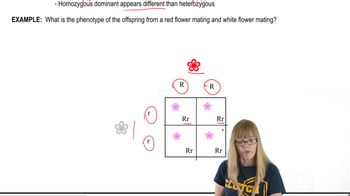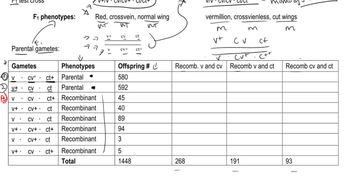Table of contents
- 1. Introduction to Genetics51m
- 2. Mendel's Laws of Inheritance3h 37m
- 3. Extensions to Mendelian Inheritance2h 41m
- 4. Genetic Mapping and Linkage2h 28m
- 5. Genetics of Bacteria and Viruses1h 21m
- 6. Chromosomal Variation1h 48m
- 7. DNA and Chromosome Structure56m
- 8. DNA Replication1h 10m
- 9. Mitosis and Meiosis1h 34m
- 10. Transcription1h 0m
- 11. Translation58m
- 12. Gene Regulation in Prokaryotes1h 19m
- 13. Gene Regulation in Eukaryotes44m
- 14. Genetic Control of Development44m
- 15. Genomes and Genomics1h 50m
- 16. Transposable Elements47m
- 17. Mutation, Repair, and Recombination1h 6m
- 18. Molecular Genetic Tools19m
- 19. Cancer Genetics29m
- 20. Quantitative Genetics1h 26m
- 21. Population Genetics50m
- 22. Evolutionary Genetics29m
4. Genetic Mapping and Linkage
Trihybrid Cross
Problem 16c
Textbook Question
In Drosophila, Dichaete (D) is a mutation on chromosome III with a dominant effect on wing shape. It is lethal when homozygous. The genes ebony body (e) and pink eye (p) are recessive mutations on chromosome III. Flies from a Dichaete stock were crossed to homozygous ebony, pink flies, and the F₁ progeny, with a Dichaete phenotype, were backcrossed to the ebony, pink homozygotes. Using the results of this backcross shown in the table, Phenotype Number Dichaete 401 ebony, pink 389 Dichaete, ebony 84 pink 96 Dichaete, pink 2 ebony 3 Dichaete, ebony, pink 12 wild type 13 Diagram this cross, showing the genotypes of the parents and offspring of both crosses.
 Verified step by step guidance
Verified step by step guidance1
Identify the genotypes of the parental generation: The Dichaete stock is heterozygous for Dichaete (D) and wild type for ebony (E) and pink (P), so its genotype is DdEePp. The homozygous ebony, pink flies have the genotype ddeepp.
Perform the initial cross: Cross the Dichaete stock (DdEePp) with the homozygous ebony, pink flies (ddeepp). The F₁ progeny will have the genotype DdEePp, showing the Dichaete phenotype due to the dominant D allele.
Backcross the F₁ progeny: Cross the F₁ Dichaete flies (DdEePp) with the homozygous ebony, pink flies (ddeepp).
Determine the expected phenotypes and genotypes: The backcross will produce a variety of phenotypes based on the recombination of alleles. Consider the possible combinations of alleles for each gene (D, e, p) and their effects on phenotype.
Analyze the phenotypic ratios: Compare the observed phenotypic numbers from the table with the expected ratios to infer linkage and recombination events.
Recommended similar problem, with video answer:
 Verified Solution
Verified SolutionThis video solution was recommended by our tutors as helpful for the problem above
Video duration:
1mPlay a video:
Was this helpful?
Key Concepts
Here are the essential concepts you must grasp in order to answer the question correctly.
Dominant and Recessive Alleles
In genetics, alleles can be classified as dominant or recessive based on their phenotypic expression. A dominant allele, such as the Dichaete mutation (D), will manifest in the phenotype even if only one copy is present. In contrast, recessive alleles, like ebony (e) and pink (p), require two copies to express their traits. Understanding this distinction is crucial for predicting the outcomes of genetic crosses.
Recommended video:
Guided course

Variations on Dominance
Homozygous and Heterozygous Genotypes
An organism is homozygous for a gene when it has two identical alleles, while it is heterozygous when it has two different alleles. In this scenario, the Dichaete mutation is lethal when homozygous, meaning that individuals with two copies of the D allele do not survive. Recognizing these genotypic classifications helps in analyzing the inheritance patterns observed in the offspring of the crosses.
Recommended video:
Guided course

Gamete Genotypes
Backcrossing and Phenotypic Ratios
Backcrossing involves mating an F₁ hybrid organism with one of its parental genotypes to analyze inheritance patterns. The resulting offspring's phenotypic ratios provide insights into the genetic contributions of the parents. In this case, the backcross of Dichaete F₁ flies to homozygous ebony, pink flies reveals the segregation of traits and helps determine the linkage and interaction between the genes involved.
Recommended video:
Guided course

Mutations and Phenotypes

 26:8m
26:8mWatch next
Master Trihybrid Cross with a bite sized video explanation from Kylia Goodner
Start learningRelated Videos
Related Practice


